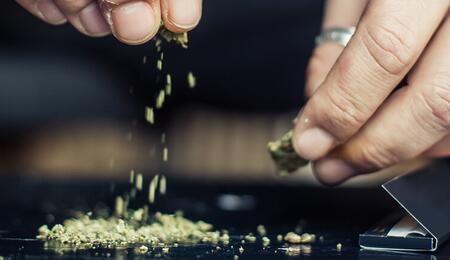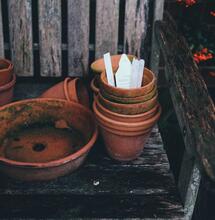Guano Is The Way To Go
10 Aug 2018

There are lots of people who have tried their hand at growing with guano, and there are many who have failed for a few simple reasons. Guano, especially bat guano, can actually be a deterrent to your crop rather than the great gift most seem to think it is. For most people the mistake made was growing in pure guano or using too much of it with another medium such as soil or peat. It should be used as an additive rather than a pure medium.
The best way to grow with guano is to use a peat / perlite mixture with guano thrown in as fertilizer. This is because guano is either too acidic or too alkaline to be used to grow cannabis in its pure form. Depending on the animal it comes from, the odor can be very strong. Use guano outside or your entire home will be infused with the smell. Even if small amounts are used, there can be quite a strong odor.
Use a peat / perlite mixture and add perlite to the peat moss at the ratios that are on the bag of perlite. It is important to wet the peat and perlite mixture before adding the guano. This is because the guano won’t mix well with a dry medium. It tends to want to stick together and form little balls.
 A good ratio of guano to peat and perlite is about four ounces of guano to one liter of peat and perlite. Mix it well with the moist peat and perlite. It should be completely mixed with no balls of guano in the medium. A moist form of guano works best for this. If a dry guano is being used, it should be moistened before being added to the peat and perlite growing medium.
Some would say that now is the time to pH balance the growing medium. While this may make sense, it is not needed. However, the water you’ll be using should be pH balanced to a range between 5.2 and 5.9. This is the optimal range for marijuana.
Now that the growing medium has been mixed, the decision will have to be made as to where you’re going to place your pot. Since wet guano smells horrid, it should be put outside somewhere. Perhaps on your deck or some other place where a large green growing plant won’t raise an eyebrow.
Another useful way to use guano is as a foliar feeder. That is, spray a very weak mixture of guano and pure pH balanced water directly on the leaves of the plant. Foliar feeding is a great way to ensure your green is getting all of the nutrients it needs. Use about an ounce of guano in 1 to 1.5 liters of water.
A few words should be given to the nutrients found in guano. Most guanos have a high amount of phosphorous, so the plant won’t be lacking that nutrient. Guano as a fertilizer is about as complete a nutrient that you’re going to find. However, it is still not a 100% complete solution. Keep an eye out for nutrient deficiencies that will usually pop up midway in the growth cycle of the plant.
Another thing to keep an eye out for is pests. Insects seem to really like the smell of guano for some reason, so choose a place for your plant that is not near a door. In this way the house won’t be deluged with insects.
Because insects are attracted to guano, some resort to covering the plant with an insect net. This will keep the insects off of your plant and has the added benefit of disguising the plant, making it possible to grow in a city on your backyard balcony. Just tell visitors that the plant under the net is a tea plant. Not a lot of people have ever seen a tea plant, so this white lie will work quite well.
By Thomas Valentine
A good ratio of guano to peat and perlite is about four ounces of guano to one liter of peat and perlite. Mix it well with the moist peat and perlite. It should be completely mixed with no balls of guano in the medium. A moist form of guano works best for this. If a dry guano is being used, it should be moistened before being added to the peat and perlite growing medium.
Some would say that now is the time to pH balance the growing medium. While this may make sense, it is not needed. However, the water you’ll be using should be pH balanced to a range between 5.2 and 5.9. This is the optimal range for marijuana.
Now that the growing medium has been mixed, the decision will have to be made as to where you’re going to place your pot. Since wet guano smells horrid, it should be put outside somewhere. Perhaps on your deck or some other place where a large green growing plant won’t raise an eyebrow.
Another useful way to use guano is as a foliar feeder. That is, spray a very weak mixture of guano and pure pH balanced water directly on the leaves of the plant. Foliar feeding is a great way to ensure your green is getting all of the nutrients it needs. Use about an ounce of guano in 1 to 1.5 liters of water.
A few words should be given to the nutrients found in guano. Most guanos have a high amount of phosphorous, so the plant won’t be lacking that nutrient. Guano as a fertilizer is about as complete a nutrient that you’re going to find. However, it is still not a 100% complete solution. Keep an eye out for nutrient deficiencies that will usually pop up midway in the growth cycle of the plant.
Another thing to keep an eye out for is pests. Insects seem to really like the smell of guano for some reason, so choose a place for your plant that is not near a door. In this way the house won’t be deluged with insects.
Because insects are attracted to guano, some resort to covering the plant with an insect net. This will keep the insects off of your plant and has the added benefit of disguising the plant, making it possible to grow in a city on your backyard balcony. Just tell visitors that the plant under the net is a tea plant. Not a lot of people have ever seen a tea plant, so this white lie will work quite well.
By Thomas Valentine
 A good ratio of guano to peat and perlite is about four ounces of guano to one liter of peat and perlite. Mix it well with the moist peat and perlite. It should be completely mixed with no balls of guano in the medium. A moist form of guano works best for this. If a dry guano is being used, it should be moistened before being added to the peat and perlite growing medium.
Some would say that now is the time to pH balance the growing medium. While this may make sense, it is not needed. However, the water you’ll be using should be pH balanced to a range between 5.2 and 5.9. This is the optimal range for marijuana.
Now that the growing medium has been mixed, the decision will have to be made as to where you’re going to place your pot. Since wet guano smells horrid, it should be put outside somewhere. Perhaps on your deck or some other place where a large green growing plant won’t raise an eyebrow.
Another useful way to use guano is as a foliar feeder. That is, spray a very weak mixture of guano and pure pH balanced water directly on the leaves of the plant. Foliar feeding is a great way to ensure your green is getting all of the nutrients it needs. Use about an ounce of guano in 1 to 1.5 liters of water.
A few words should be given to the nutrients found in guano. Most guanos have a high amount of phosphorous, so the plant won’t be lacking that nutrient. Guano as a fertilizer is about as complete a nutrient that you’re going to find. However, it is still not a 100% complete solution. Keep an eye out for nutrient deficiencies that will usually pop up midway in the growth cycle of the plant.
Another thing to keep an eye out for is pests. Insects seem to really like the smell of guano for some reason, so choose a place for your plant that is not near a door. In this way the house won’t be deluged with insects.
Because insects are attracted to guano, some resort to covering the plant with an insect net. This will keep the insects off of your plant and has the added benefit of disguising the plant, making it possible to grow in a city on your backyard balcony. Just tell visitors that the plant under the net is a tea plant. Not a lot of people have ever seen a tea plant, so this white lie will work quite well.
By Thomas Valentine
A good ratio of guano to peat and perlite is about four ounces of guano to one liter of peat and perlite. Mix it well with the moist peat and perlite. It should be completely mixed with no balls of guano in the medium. A moist form of guano works best for this. If a dry guano is being used, it should be moistened before being added to the peat and perlite growing medium.
Some would say that now is the time to pH balance the growing medium. While this may make sense, it is not needed. However, the water you’ll be using should be pH balanced to a range between 5.2 and 5.9. This is the optimal range for marijuana.
Now that the growing medium has been mixed, the decision will have to be made as to where you’re going to place your pot. Since wet guano smells horrid, it should be put outside somewhere. Perhaps on your deck or some other place where a large green growing plant won’t raise an eyebrow.
Another useful way to use guano is as a foliar feeder. That is, spray a very weak mixture of guano and pure pH balanced water directly on the leaves of the plant. Foliar feeding is a great way to ensure your green is getting all of the nutrients it needs. Use about an ounce of guano in 1 to 1.5 liters of water.
A few words should be given to the nutrients found in guano. Most guanos have a high amount of phosphorous, so the plant won’t be lacking that nutrient. Guano as a fertilizer is about as complete a nutrient that you’re going to find. However, it is still not a 100% complete solution. Keep an eye out for nutrient deficiencies that will usually pop up midway in the growth cycle of the plant.
Another thing to keep an eye out for is pests. Insects seem to really like the smell of guano for some reason, so choose a place for your plant that is not near a door. In this way the house won’t be deluged with insects.
Because insects are attracted to guano, some resort to covering the plant with an insect net. This will keep the insects off of your plant and has the added benefit of disguising the plant, making it possible to grow in a city on your backyard balcony. Just tell visitors that the plant under the net is a tea plant. Not a lot of people have ever seen a tea plant, so this white lie will work quite well.
By Thomas Valentine



.png)